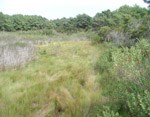
NPS Photo One of the most important grasses on the island is American beachgrass (Ammophila breviligulata), which stabilizes sand dunes and reduces erosion from wind. It continues to grow as sands blow over its stems, sometimes creating up to 40 feet of buried plant above the roots. Because of this trait, it is often planted during beach restoration projects. Specific habitats on the island where grasses are the dominant plants include: brackish tidal marshes characterized by cattail (Typha angustifolia); marshes dominated by common reed or needlerush (Juncus roemerianus); saltwater cordgrass (Spartina alterniflora) marshes; interdunal sand bogs characterized by pathrush (Juncus dichotomus) and sundew (Drosera intermedia); and other dune, interdune, and bayside plant communities. |
Last updated: February 6, 2017
